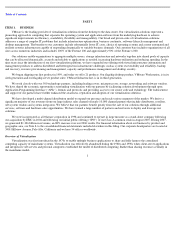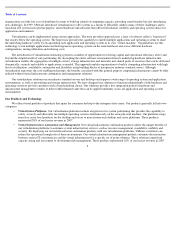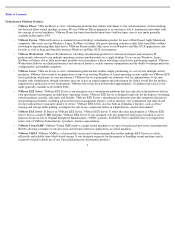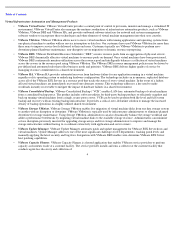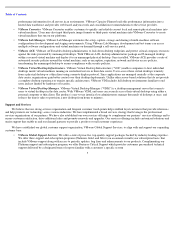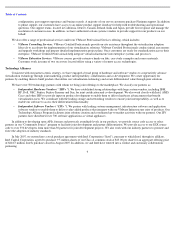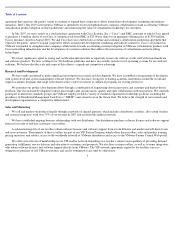VMware 2007 Annual Report Download - page 13
Download and view the complete annual report
Please find page 13 of the 2007 VMware annual report below. You can navigate through the pages in the report by either clicking on the pages listed below, or by using the keyword search tool below to find specific information within the annual report.
Table of Contents
One of our distribution relationships is with Ingram Micro, which accounted for 23% of our worldwide revenues in 2007. The agreement
under which we receive the substantial majority of our Ingram Micro revenues is terminable by either party upon 90 days’ prior written notice to
the other party, and neither party has any obligation to purchase or sell any products under the agreement. Additionally, Arrow Electronics and
Hewlett Packard Company accounted for 12% and 11% of revenues in 2007, respectively. No other channel partner accounted for more than
10% of our revenues in 2007.
Competition
The virtual infrastructure market is evolving, and during 2007 we experienced increased competition and we expect competition to
significantly intensify in the future. We compete with large and small companies in different segments of the virtualization market, and expect
that new entrants will continue to enter the market and develop technologies that, if commercialized, may compete with our products.
We believe that the key competitive factors in the virtual infrastructure market include:
Microsoft is our primary competitor for virtualization solutions. Microsoft currently provides products that compete with some of our
entry-level offerings and has announced its intention to provide products that will compete with some of our enterprise-class products in the
future. Microsoft has made a number of announcements recently regarding initiatives in this area, including acquisitions, and they may become a
more significant competitor in the future, given their significant resources. We have developed our virtualization solutions as a software layer
between the hardware and the operating system that is not tied to a specific operating system. We also have an expert advanced vision of the
manager and automated data center. We believe our approach and roadmap is differentiated from Microsoft’s and delivers significant flexibility,
functionality, reliability and superior economic value to customers.
We also compete with companies whose products are based on emerging open-source technologies for system virtualization. In addition,
we compete with companies that take different approaches to virtualization. However, we believe these solutions offer limited support for
heterogeneous operating system deployments. Furthermore, our VMware Infrastructure suite competes with products that provide high
availability clustering, workload management and resource management.
We also expect to compete with new entrants to the virtualization market, which may include parties currently selling our products or our
current technology partners. Additionally, some of our competitors may make acquisitions or enter into partnerships or other strategic
relationships with one another to offer a more comprehensive virtualization solution than they individually had offered. Some competitors have
in the past and may in the future take advantage of their existing relationships with our business partners to engage in business practices such as
distribution and license restrictions that make our products less attractive to our channel partners and end users. A number of companies have
recently announced initiatives in these areas. Many of our
9
•
the level of reliability and new functionality of product offerings;
•
the ability to provide full virtual infrastructure solutions;
•
the ability to offer products that support multiple hardware platforms and operating systems;
•
the proven track record of formulating and delivering a roadmap of virtualization capabilities;
•
pricing of products, individually and in bundles;
•
the ability to attract and preserve a large installed base of customers;
•
the ability to create and maintain partnering opportunities with hardware and infrastructure software vendors and development of
robust indirect sales channels; and
•
the ability to attract and retain virtualization and systems experts as key employees.




